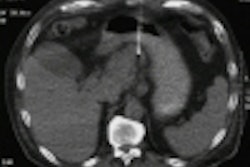Notwithstanding a higher incidence of osteoporosis in Taiwan, quantitative ultrasound (QUS) measurements of bone mineral density in Taiwanese patients were similar to those of other patient populations, according to a large-scale study published in the British Journal of Radiology.
The study had two goals: First, to establish bone mineral density using QUS in subjects with no obvious disease who were undergoing routine health examinations. Second, to determine risk factors for osteoporosis in Taiwan and provide better prevention and treatment measures. Researchers from Chang Gung Memorial Hospital in Taiwan conducted the two-year prospective study.
Broadband ultrasound attenuation of the right heel was measured using an Achilles bone densitometer (GE Medical Systems Lunar, Madison, WI). Of the 16,862 patients participating in the study from January 1996 to December 1997, 9,314 were women with a mean age of 51.5 years. The 7,548 men had a mean age of 51.1 years (BJR, August 2001, Vol.74:884, pp. 602-606).
The patients had no history of major diseases and, after the exam, those with diabetes or other endocrine disorders were excluded, according to the study team. Subjects who presented with edema or a foot abnormality were also excluded from the study.
The researchers found that the incidence of osteoporosis in all subjects increased from 1.13% in the group ages 21-30 to 54.55% in those over 80. Of the total subjects, 12.02% had osteoporosis, while 34.45% had osteopenia. From multivariate analysis, the researchers discovered that bone density evaluated by QUS showed a relationship with age, gender, body mass index, waist/hip ratio, smoking, and frequency of exercise.
"For aging women in this part of the world, the incidence of osteoporosis is higher than in the USA," the researchers wrote. "As BMD increased with [body mass index], our results are similar to recent studies."
However, the role of QUS in predicting fractures in Taiwan requires further investigation, the researchers wrote. Other investigators have reported mixed results with assessing BMD by QUS.
In a study from the University Hospital Jean Minjoz in Besançon, France, rheumatologists used QUS to examine the changes in BMD and body composition of patients with ankylosing spondylitis (AS). The patients had significantly lower lumbar spine, femoral neck, and total body BMD as compared with controls based on the QUS exam, they reported. However, QUS did not provide additive information to dual-energy x-ray absorptiometry (DEXA) scans (Rheumatology, August 2001, Vol.40:8, pp. 882-888).
On the other hand, investigators from the University of Pittsburgh tested out a QUS-2 calcaneal ultrasonometer on 1,401 women in order to identify those with low bone mass. They concluded that the QUS-2 calcaneal ultrasonometer exhibited "reproducible clinical performance that is similar to BMD of the spine and hip in identifying women with low bone mass and discriminating women with fracture from those without" (Osteoporosis International, 2001, Vol.12:5, pp. 291-298).
By Erik L. RidleyAuntMinnie.com staff writer
September 19, 2001
Related Reading
Criteria for osteoporosis screening in women with RA confirmed, August 8, 2001
Copyright © 2001 AuntMinnie.com




















